Lane-changing Escalade splurges atop SUV list
By John Gilbert
The debate has been long-standing. Which manufacturer makes the best vehicle in the world? And, which manufacturer makes the all-out most luxurious vehicle in the world? Cadillac figures you can use the same answer to solve both questions.
And with as much restraint as Cadillac can summon, it presents its entry — the 2021 Cadillac Escalade Platinum.
There is no such thing as a common, garden-variety Escalade. The most basic Escalade is spectacular, loaded with luxury features and creature comforts for every occupant. But if the competition is for the top rung on the luxury ladder, no feature can be left out, and a few that you’ve never imagined must be incorporated.
For example, all of the top General Motors gadgets are in place, with the 6.2-liter V8 under the hood and s smooth-shifting 10-speed automatic transmission distributing the power to all four wheels, which, by the way, are 22-inch, polished 10-spoke alloys
The ride is smooth, thanks to air-ride adaptive suspension, and magnetic ride control..
The audio sound is spectacular, too, thanks to the AKG studio reference sound system, with 36 — count ‘em, 36! — speakers scattered around the interior. Two of them are included in either side of the front bucket headrests, just so your ears won’t have to strain to hear a speaker as much as four inches away from your head.
But in this era when companies are experimenting with autonomous driving vehicles, the brilliance of electronic devices that can sense other vehicles ahead, behind and beside you, and even pedestrian detection, are pretty common. Along with them, adaptive cruise control allows a driver to not worry about the car ahead, because your vehicles computer, radar, sonar systems will do it for you, maintaining the following distance and either speeding up or slowing down to compensate.
Those things are safety amenities, not just neat features, and among my favorites are the top lane-departure warning units that can first, alert you that you’ve allowed your vehicle to wander across the lane-divider line, and second, keep you in place with a gentle nudging of steering wheel pressure in case your lack of attention has reached the critical stage. Third is lane-centering, which I first experienced when Hyundai introduced its last-generation Santa Fe. It not only keeps you in your lane, but keeps your car centered in that lane — so effectively that you literally could drive home without touching the steering wheel.
I am not a fan of total autonomous driving, where the driver can read a book or magazine instead of paying attention to where the car is taking you. To me, maintaining oversight is mandatory, although those things change over time.
But Cadillac has come up with a new wrinkle that takes lane departure warning and assistance to new levels. We could call is forced lane-change, because it actually does change lanes with the same precision that lane-keeping does its thing.
Visualize this, now. You are driving down a three-lane freeway, and you’re in the center lane, cruising along at, say, the speed limit of 70 mph. Sometimes, when you want to make a lane-change, or take the next exit, you might put light pressure on the directional signal stalk to get only two or three blinks without locking on.
With the new Escalade, if you put that sort of pressure on the stalk to the left, for example, the Escalade’s sensors will make sure there is adequate room, and then it will veer you into that left lane without any input by you on the steering wheel.
Going back to Hyundai, with the Palisade light pressure or full turn-signal pressure on the stalk will give you a little video of the lane to whichever side you are intending to change to, which is a wonderful advantage to make sure you haven’t missed something creeping into your blind spot. But Cadillac has taken a giant step beyond that.
I am little nervous trusting a manufacturer — even Cadillac — to do my lane-checking for me, but in congested freeway driving, it might be a true safety feature if your vehicle can check the lane next to you, and at the same time detect a large enough slot three cars back that would allow something as large as your Escalade to fit, and then put you there.
It works for perfect parking assist on a lot of new vehicles these days — another feature you surely will feel uneasy about until you’ve executed it 20 or 30 times and found that it always backs you up, enters the parking space, and squares you away with perfect, driver’s-license-test precision. The first few times, you get out and walk around to verify it’s OK, and you find that it is perfectly placed, near, but not up against, the curb.
Needless to say, the Escalade is expensive, and the new one with all the trick stuff is right up there with the top models from Mercedes, or Land Rover, or Lexus. And why not? The technology costs plenty, and buyers will expect to pay the toll..
My test-drive Escalade Platinum started at a sticker price of $102,995, and the assist-step running boards, perimeter lighting, puddle lamps, and a cavernous console that becomes a cooler, boosts the bottom line to $109,500.
For that, you ride in supreme comfort, with little items such as an adjustable multi-colored LED strip along the top of the steering wheel so you can match your mood to blue, orange, green or purple with ease. Rear-seat passengers have their own air-conditioning controls, and video screens built in on the rear of the front-seat headrests. The rear seats slide fore and aft, and the back rests fold down perfectly flat to allow easy access to the third row, where three more occupants can fit. Up front, there is leather on top of the dash, and the tan-color leather on the seats stands out particularly with the Shadow Metallic shade of dark grey on the exterior. The seat color is called Whisper Beige, with Gideon accents.
The ceiling is almost all glass, with a huge, panoramic sunroof letting in as much light or air as you can stand, and whatever amount of the ceiling is not glass is suede leather, making you feel definitely pampered in your leather-wrapped luxury.
Naturally, the 6.2 V8 dispenses plenty of power, but I was pleasantly surprised that the big engine and hefty, square-back Escalade delivered better than the EPA estimated fuel economy of 14 miles per gallon city and 19 highway. We got just about exactly the city mileage, with 13.5, but we beat the highway numbers by recording 21.2 mpg on a couple of freeway trips.
That is certainly not the best fuel economy you can find among large SUVs, but it is better than I anticipated, and definitely adequate while we await the planned and promised switch from fossil-fuel gas-powered engines to all-electric. It won’t be long, maybe four more years, and if the EV version of the Escalade retains all the creature features of the 2021 model, it will be a sellout. Even if, by then, it insists on driving you home.


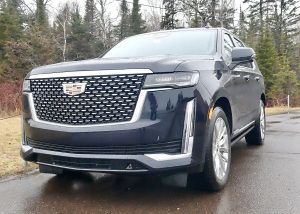
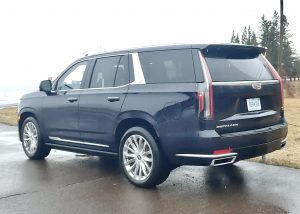
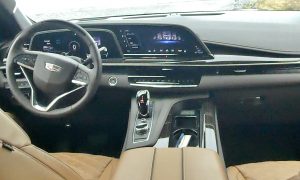
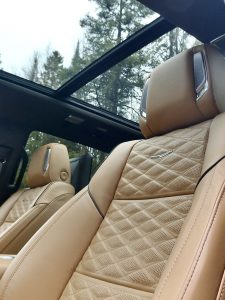
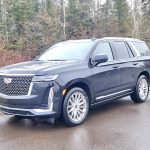
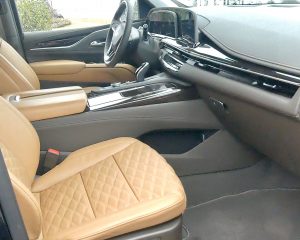
 John Gilbert is a lifetime Minnesotan and career journalist, specializing in cars and sports during and since spending 30 years at the Minneapolis Tribune, now the Star Tribune. More recently, he has continued translating the high-tech world of autos and sharing his passionate insights as a freelance writer/photographer/broadcaster. A member of the prestigious North American Car and Truck of the Year jury since 1993. John can be heard Monday-Friday from 9-11am on 610 KDAL(www.kdal610.com) on the "John Gilbert Show," and writes a column in the Duluth Reader.
John Gilbert is a lifetime Minnesotan and career journalist, specializing in cars and sports during and since spending 30 years at the Minneapolis Tribune, now the Star Tribune. More recently, he has continued translating the high-tech world of autos and sharing his passionate insights as a freelance writer/photographer/broadcaster. A member of the prestigious North American Car and Truck of the Year jury since 1993. John can be heard Monday-Friday from 9-11am on 610 KDAL(www.kdal610.com) on the "John Gilbert Show," and writes a column in the Duluth Reader.